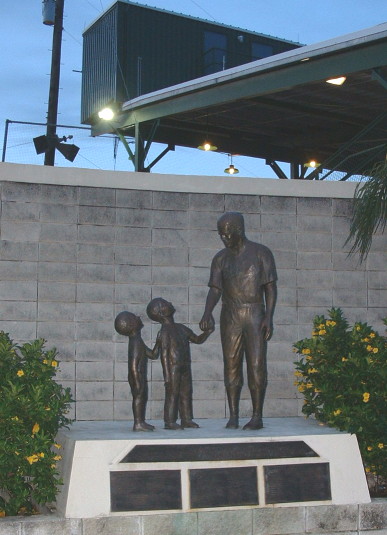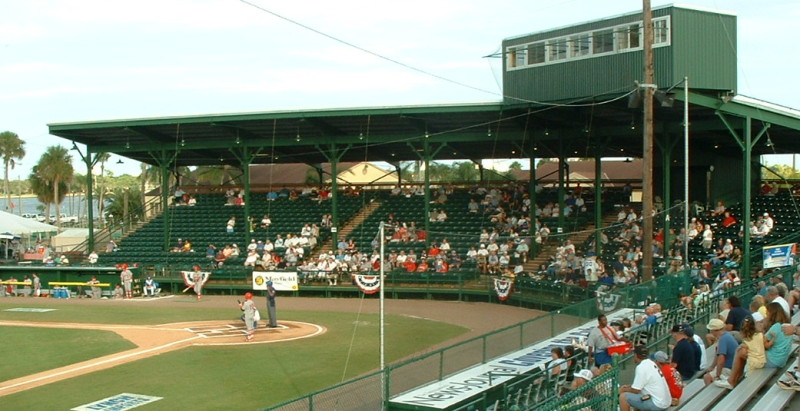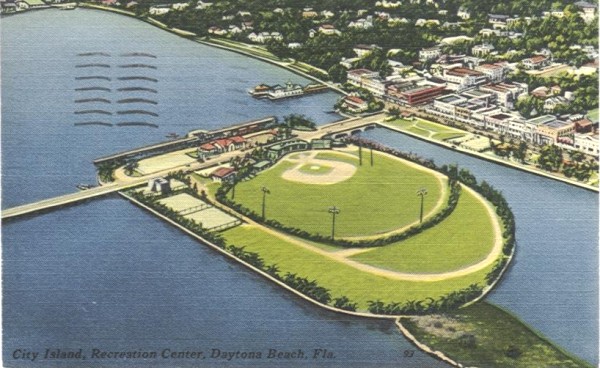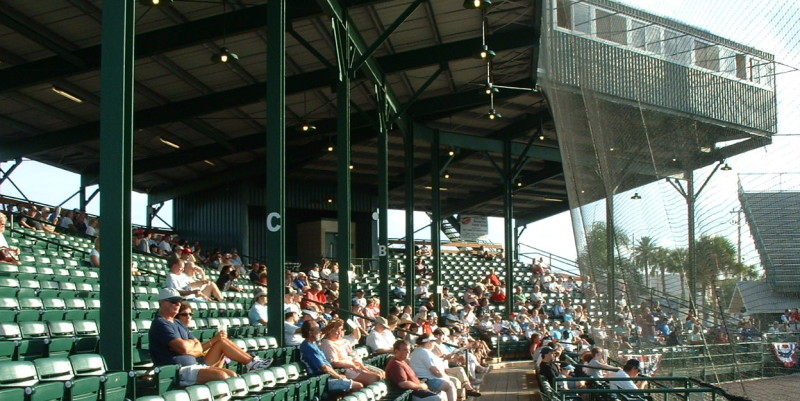You don’t get any more Floridian than Jackie Robinson Ballpark, home of the Daytona Cubs of the Florida State League. Much of Florida’s baseball history intersects on this small island outside of downtown Daytona Beach, while one of the most important events in baseball history took place there as well.
FAST FACTS
Year Built: 1930
Capacity: 4,000
Dimensions: 317L, 400C, 325R
Website: daytonacubs.com
Phone: 386/257-3172
League: Florida State League (High Class A)
Affiliation: Chicago Cubs
Parking: There is adequate parking on the street next to the ballpark and in the parking lot beyond the outfield wall. Address/Directions: 105 E. Orange Av., Daytona Beach, Florida. The ballpark is in the heart of downtown Daytona Beach. If you’re coming in on I-95, take the east Hwy. 92 exit and hang a right on Beach Street just before you hit the water; the ballpark is a block away on the left. If you’re coming in on Hwy. 1, head east on Orange Avenue; the ballpark is two blocks on your left.
For those reasons alone Jackie Robinson Ballpark would be worth a visit. But a ballpark cannot totally be a museum, and it would be unfair to the folks who run the Daytona Cubs to judge the ballpark wholly on its history. When evaluated as a working ballpark, Jackie Robinson Ballpark succeeds: it’s a comfortable, cozy place to watch a Class A game. It may not be as large as the new breed of Class A ballparks found in the Midwest and Sally league, and it’s not as new as the newer ballparks in the Florida State League that also serve as spring-training facilities, but Jackie Robinson has atmosphere and location — two things are increasingly rare in Class A parks.
Jackie Robinson Ballpark is located on a small island between downtown Daytona Beach and the oceanfront. You want scenic? A city marina sits to the southeast of the ballpark (which serves as a great backdrop to those fans sitting in the left-field seats), while the waterfront and downtown sits to the southwest of the ballpark (serving as a great backdrop for those sitting on the first-base side, especially after twilight when downtown lights up). During our visit, the waterfront location was particularly advantageous: it was a particularly warm August night (even by Florida standards), but by the third inning a sweet cool breeze was wafting off the water and through the stadium. All in all, it made for a gorgeous evening.
There’s been a ballpark at this location since 1914, when the first stadium was called Daytona City Island Ballpark, with the Daytona Beach Islanders joining the Florida State League in 1920. It wasn’t much of a ballpark, consisting mainly of wooden bleachers, but the stadium was upgraded when Islanders became a constant presence in the FSL. Since then, there has been FSL teams in Daytona off and on, with the Daytona Cubs part of the league since 1993. Much of today’s ballpark configuration dates back to the 1920s, when a grandstand and press box was constructed (replacing the original wooden bleachers), two covered sections of grandstands, one uncovered set of bleachers and a segregated section were added, and the road circling the ballpark was first built. (The segregated area was built to comply with Florida’s Jim Crow seating laws.) However, much of this was replaced in 1951 when the ballpark was updated, but these enhancements were blown away in 1960 by Hurricane Donna. At that time the city debated whether to completely tear down the ballpark due to the extensive damage, but the city commissioners voted to restore the park, and by 1962 new grandstands and press box were added, additions that survive to this day. Additional clubhouses and bleachers were added in 1972 and 1973 when the Montreal Expos used the stadium for spring training, and the current grandstand roof dates back to 1999, replaced when Hurricane Floyd tore some sections off the old roof. All of this makes dating the opening of the present-day park somewhat problematic: the Cubs use both 1917 and 1930 as dates when the park opened while the National Trust for Historic Preservation uses 1915, but the more accurate dating for the current stadium might be 1962.
Daytona officials and team owners have been working to stress the historic part of the ballpark, which could end up leading to some changes to the park in the future. The history is significant: It was at this ballpark that Jackie Robinson actually broke the color line in baseball when he played in a spring-training exhibition as a member of the Montreal Royales of the International League in March 1946, his first stop before joining the Brooklyn Dodgers. In 1946 the Dodgers and the Royales were turned away from several previously scheduled spring-training exhibitions when word got out that Robinson was to take the field for the Royales: In Sanford, the police chief threatened to stop the game if Robinson did not leave the field; in Jacksonville, the stadium was padlocked shut on game day, and in nearby DeLand the scheduled day game was called off on account of faulty electrical lighting. However, Robinson and the Royales were allowed to take the field in Daytona, and the following season Robinson broke the color line at the major-league level. The city named the ballpark after Robinson in 1988, and the stadium was placed on the National Register of Historic Places in November 1988.
If you go to an evening game, be careful where you sit. The most comfortable seats are in the restored grandstand section; the VIP seats are wider than your average box seat (space that came in handy when holding a seven-month-old daughter, as I was), but you’ll spend the first four innings or so fighting off the sun. You’ll want to sit in the more uncomfortable third-base bleachers at the start of the game: even though they are not shaded, you’ll have your back to the sun and if you’re sitting in the front box seats you’ll be in the shade after an inning or so.
CONCESSIONS
There’s one main concession stand behind the third-base bleachers; food and pop is sold on one side and beer is sold on the other.
The hot dogs at Jackie Robinson Ballpark are simply outstanding and are almost worth the trip on their own. The Cubs serve Red Hot Chicago hot dogs, and every Wednesday night the Cubs sell them for $1.
If you’re sitting in the VIP seats, an attendant will serve you concessions in your seats. If you’re not, you can buy a Sno-Kone from one of the entertaining young men wandering through the stadium.
WHERE TO STAY
Just down Hwy. 1 (also marked as Ridgewood Avenue) from the ballpark is the Days Inn Daytona Beach (544 S. Ridgewood Av.).
However, the ballpark is also less than a mile away from the famous Daytona Beach (yes, the real beach, complete with sand and thongs galore), and there are a number of hotels near the waterfront. There are a ton of hotel rooms at Daytona Beach, and many of them are located within two miles of the ballpark.
FOR THE KIDS
A supervised kids’ play area is located behind the first-base bleachers.
BEFORE/AFTER THE GAME
Of course, a stop at the world-famous Daytona Beach is mandatory. Or, rather, the Daytona beaches: the city sits next to 23 miles of white-sand beaches that be accessed at various points from the city. At low tide the beaches are 500 feet wide, and you can actually drive on the beach on a marked 18-mile stretch. (If you get off this trail and park your vehicle, watch out for the tide.)
After the game, head down to Aunt Catfish’s (4009 Halifax Dr., Port Orange; 904/761-2744) for one of the best catfish meals you’ll find anywhere. (From the ballpark, go to Ridgewood Av./Hwy. 1, turn south, and go down four miles until you reach the Hwy. A1A/Dunlawton Av. intersection. Aunt Catfish’s is on the left.) Though there is a lot of seafood and rubs on the menu, the house specialty is catfish. The sampler plate with catfish broiled, Carolina-style and baked is a good choice for those unacquainted with this Southern specialty.





